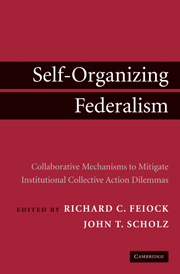 Self-Organizing Federalism
Self-Organizing Federalism Book contents
- Frontmatter
- Contents
- List of Figures
- List of Tables
- Contributors
- Preface
- PART ONE SELF-ORGANIZING VERSUS CENTRALIZED SOLUTIONS TO INSTITUTIONAL COLLECTIVE ACTION PROBLEMS: THEORETICAL CONSIDERATIONS
- PART TWO INTEGRATING METROPOLITAN SERVICE PROVISION: NETWORKS, CONTRACTS, AGREEMENTS, AND SPECIAL DISTRICTS
- PART THREE INTEGRATING REGIONAL POLICIES THROUGH NETWORKS, JOINT VENTURES, AND PARTNERSHIPS
- 9 Collaborative Institutions, Functional Areas, and Beliefs: What Are Their Roles in Policy Networks?
- 10 Sustaining Joint Ventures: The Role of Resource Exchange and the Strength of Interorganizational Relationships
- 11 Institutional Collective Action in an Ecology of Games
- 12 Enhancing Vertical and Horizontal Self-Organization: Harnessing Informal Networks to Integrate Policies within and between Governments in the European Union
- PART FOUR SELF-ORGANIZING GOVERNANCE AND INSTITUTIONAL COLLECTIVE ACTION
- References
- Index
9 - Collaborative Institutions, Functional Areas, and Beliefs: What Are Their Roles in Policy Networks?
from PART THREE - INTEGRATING REGIONAL POLICIES THROUGH NETWORKS, JOINT VENTURES, AND PARTNERSHIPS
Published online by Cambridge University Press: 29 January 2010
- Frontmatter
- Contents
- List of Figures
- List of Tables
- Contributors
- Preface
- PART ONE SELF-ORGANIZING VERSUS CENTRALIZED SOLUTIONS TO INSTITUTIONAL COLLECTIVE ACTION PROBLEMS: THEORETICAL CONSIDERATIONS
- PART TWO INTEGRATING METROPOLITAN SERVICE PROVISION: NETWORKS, CONTRACTS, AGREEMENTS, AND SPECIAL DISTRICTS
- PART THREE INTEGRATING REGIONAL POLICIES THROUGH NETWORKS, JOINT VENTURES, AND PARTNERSHIPS
- 9 Collaborative Institutions, Functional Areas, and Beliefs: What Are Their Roles in Policy Networks?
- 10 Sustaining Joint Ventures: The Role of Resource Exchange and the Strength of Interorganizational Relationships
- 11 Institutional Collective Action in an Ecology of Games
- 12 Enhancing Vertical and Horizontal Self-Organization: Harnessing Informal Networks to Integrate Policies within and between Governments in the European Union
- PART FOUR SELF-ORGANIZING GOVERNANCE AND INSTITUTIONAL COLLECTIVE ACTION
- References
- Index
Summary
Policy arenas with multiple and interdependent functional purposes are common. Such fragmented policy arenas create institutional collective action (ICA) problems where activities in one functional area interfere with activities in another. This chapter explores the structure of fragmentation and the roles of two mechanisms for mitigating institutional collective action dilemmas: informal policy networks and collaborative institutions.
One of the best case studies for examining fragmentation is San Francisco Bay-Delta water policy, which combines several functional purposes including mitigating flood risks, obtaining water quality standards, protecting endangered species, and supplying water to farmers and urban areas. The San Francisco Bay-Delta water policy arena also involves a large number of actors from local, state, and federal governments and from private and nonprofit organizations. These actors vary in their level of agreement about the seriousness of water-related problems and support for policy alternatives (Munro 1993; Zafonte and Sabatier 1998; Hundley 2001; Heikkila and Gerlak 2005). This chapter examines the structure of the informal networks of allies and opponents in this fragmented and contentious arena, as well as the role of CALFED, a large collaborative institution.
INSTITUTIONAL COLLECTIVE ACTION HYPOTHESES
Analytical frameworks emphasize the important elements to study in a system, enabling the creation of theories and the derivation of hypotheses. A case in point is the ICA framework in Feiock and Scholz Chapter 1, which lays out broad guidelines for studying self-organizing governance.
- Type
- Chapter
- Information
- Self-Organizing FederalismCollaborative Mechanisms to Mitigate Institutional Collective Action Dilemmas, pp. 179 - 203Publisher: Cambridge University PressPrint publication year: 2009


